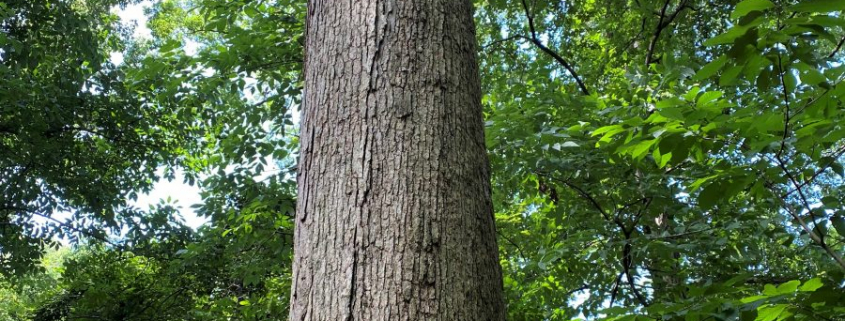Multi-Use Trail at Joe Wheeler State Park
Bear with me as I repeat some of the introductory paragraph from my August 12, 2020 Post about Nature reclaiming an 80-year-abandoned recreation area on the Joe Wheeler State Park bluffs above Wilson Lake on the Tennessee River: https://stevejonesgbh.com/2020/08/12/long-abandoned-recreation-area-at-joe-wheeler-state-park/ July 7, 2020, Alabama State Parks Naturalist Emeritus Mike Ezell and I hiked the Park’s 2.5-mile Multi-Use Trail. I focused that prior Post on the ruins of the recreation area that had operated during the heyday of Wheeler Dam construction when thousands of workers lived nearby. I take a different tack with this Post.
Trailhead and Riparian Forest
We parked near the trailhead sign (below left), hiked the sweeping loop-trail counter-clockwise, taking us first through riparian forest, briefly along the lake shore (below right), then rising onto the bluffs and the abandoned recreation site. I focus this Post on the forest, tree oddities, fungi, and flowers we encountered as we made our way to and beyond the recreation area ruins.
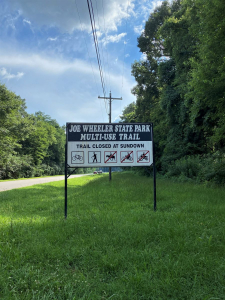
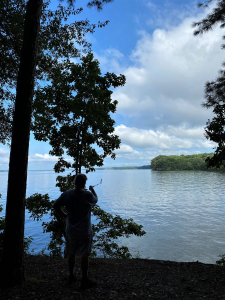
The riparian and lower-slope trail sections crossed land cutover during the same period when TVA crews were clearing towns, homes, churches, other structures, fences, and forests from below the projected high water shoreline for the designed impoundments behind both Wilson and Joe Wheeler Dams. On what is now State Park lands, forests regenerated naturally (we saw no evidence of planted stands) from the cutover forests and from cropland or pasture abandoned at the same time… 80+ years ago. Large grapevines (below) drape from high in the canopy. Try to visualize this rich riparian area in the 1930s as recently cutover… dense with stump sprouts (trees and grapevines), seedlings, woody shrubs, blackberries, and herbaceous growth, nearly impenetrable. Picture ten years later the better-positioned, faster growing individual saplings muscling the competition, reaching skyward, overwhelming the slower growing individuals and species. By age fifteen most of the herbaceous vegetation and briers are disappearing from the shaded understory. The grapevines grow tenaciously, step by step and year to year, with the trees ascending to dominance. Many people believe mistakenly that grapevines climb our forest trees, winding and grasping from the forest floor lifting along the trunk into the canopy, finding light where they can. Instead, the vines ascend with the tree, always within the treetops whether the tree is a twenty-foot sapling at age 15 or a mature 110-foot, 80-year-old dominant oak.
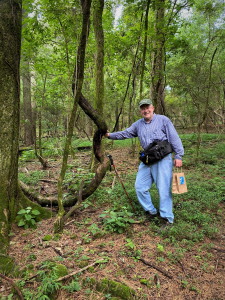
Aerial roots (see below) hang from a crook in the vine where my hand rests above. I recognized these ever-ready roots immediately, understanding from my long-ago forestry education that such adaptations await some potential stress or force of nature that may not be apparent. Leonardo da Vinci offered explanation for any such just-in-case physical attribute:
While human ingenuity may devise various inventions to the same ends, it will never devise anything more beautiful, nor more simple, nor more to the purpose than nature does, because in her inventions nothing is lacking and nothing is superfluous.
A Mississippi State Cooperative Extension online reference sheds some light and a shade of uncertainty to these intriguing protuberances: Aerial root formation in Vitis has been documented on different grape species; however, the driving forces behind the formation of adventitious roots are not well understood. In tropical areas and greenhouse situations, aerial roots in the grape family (Vitaceae) are common. In these regions, roots that form adventitiously on aerial portions of the vine may provide an adaptive response mechanism to avoid drought or flooding or provide other unknown functions. Regardless of the expressed doubt as to function or need, I side with da Vinci’s 500-year-old wisdom — these fine red tendrils have real purpose in the vast sweep of the life of grapevines on Tennessee River riparian flats. Nothing in Nature is superfluous. Their form, function, and purpose are curious only to us who have never felt the wrath of a wild river free of Corps of Engineers containment, in full-flood slamming the towering tree to the ground, transporting it ten miles downriver, and depositing it in the silty debris from the thousand-year flood. Its trailing grapevine companion thrust into the rich new soil, exciting the ever-ready adventitious cells of the aerial root to exploit the fertile new location. It quickly generates shoots to vegetatively propagate the vine that will accompany another oak as it reaches toward the heavens on the newly flood-scoured and refreshed riparian terrace above the river. Nothing is superfluous!
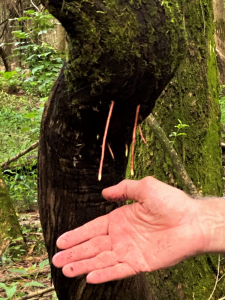
No grapevine managed to ascend with this white oak (Quercus alba) beauty. As I continue to write these Posts, each one reminds me that I should have an instrument for measuring height. I estimated this one at 110-feet. In my field of forestry, nothing represents site quality (inherent fertility and site productivity) better than height over time-certain. The tree below signals a rich site… offering firm footing, abundant moisture, and a full diet of soil nutrients.
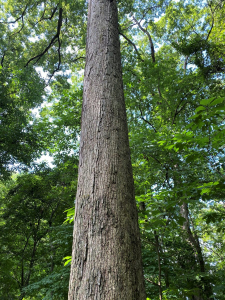
Mike stood in awe and with a dose of humility gazing into the crown of this towering monument to rich soils, long growing seasons, abundant annual rainfall, and 80-90 years without major disturbance. Pausing by such monarchs offers sufficient reward for venturing forth in the midst of our southern summer. I think of traveling a major toll road, stopping periodically to pay for the limited access privilege. I viewed our passage along the Multi-Use Trail as the toll road mirror image. Occasionally we stopped to collect direct payment in form of a regal oak, aerial roots on a grapevine, colorful mushrooms, or summer floral riches. Memories and a photo-record serve as receipts… a record of our passage.
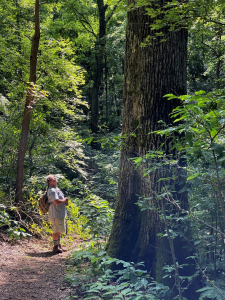
I remain on the lookout for what I classify as tree form oddities during my woods ramblings. Combine some peculiarity with large tree stature and I’m immediately sold. Mike stands beside a mossy-bottomed white oak with a coarse seam spiraling clockwise up the trunk. I speculate that this healed scar resulted from a relatively weak lightning strike that deadened a narrow strip of cambium without dealing an explosive blow. I’ve seen the result of powerful strikes shattering even large trees. I’ve pondered whether trees already wet with torrential downpours conduct the strike along the surface without serious damage. A dry tree strike perhaps travels through the wood with far greater, sometimes fatal, results. This one offers a nicely (and naturally) welded callous seam. Nature is adept at handling any and all eventualities.
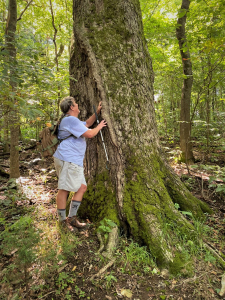
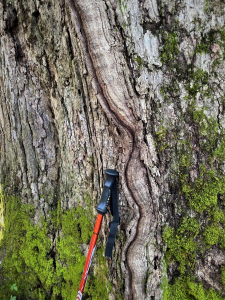
Yet another massive white oak demonstrated its mastery of the high canopy. We puzzled over how many nearby neighbors lost the battle for sunlight and soil resources, succumbing over the eight decades as this superior competitor took all the room it needed to thrive. Poison ivy vines accompanied its skyward journey. Better to climb with the tree than to compete with it for the precious high-canopy sunlight. I’ve heard people pontificate on the peace and serenity of the forest, asking why can’t we humans live in the same mode of absolute tranquility as we see in the deep forest? This individual tree commands nearly one-quarter of an acre, its canopy spreading some 50 feet in radius. Just 5.5 oaks this size occupy an area equivalent to an acre. The first 2-3 years after the new forest began to develop in the mid-1930s, hundreds (maybe thousands) of mixed woody plant individuals occupied that same area. Fierce competition defined the days, weeks, months, and years; nearly all stems present at the outset met with demise. The brutal competition continues.
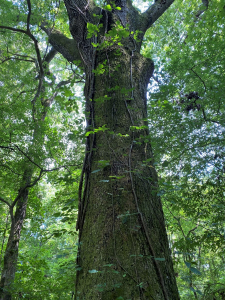
I’ve focused on the survivors, the successful main canopy competitors. Let’s switch focus now to a wider cycle that includes but is not limited to the main canopy surviving giants.
Forest Life, Death, and Decay
This 30-inch diameter white oak appears healthy at first glance, yet a sixth of its circumference evidences death and decay within. Fungi fruiting bodies proliferate on the bark as the mycelia feed on the woody fibers within. A violent windstorm or catastrophic lightning strike can bring an otherwise vibrant tree to immediate demise. Other forces, like our ubiquitous decay fungi, act over time and co-survive for decades reducing vigor and weakening structural soundness. I remind readers that even the mighty oak will one day enter the ongoing, never ending cycle of life and death, returning its carbon to the soil.
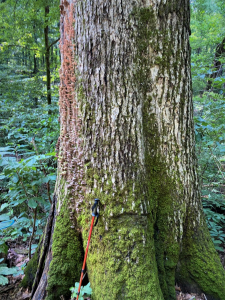
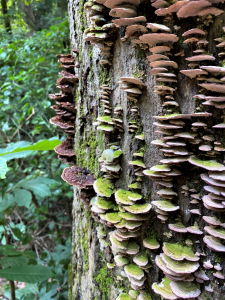
Fungi don’t limit their activity to standing trees, dead and alive. The Coprinopsis (genus) mycelia (below left) are exploiting the visible fallen branch. The rounded earthstar (Below right; Geastrum saccatum) caught my eye and captured my imagination. MushroomExpert.com described this fascinating fruiting body as a small but beautiful mushroom that features a round spore case sitting atop a star with 4-9 arms. When ripe, the spore case erupts from its center-top spewing contents for dissemination to other dead woody material.
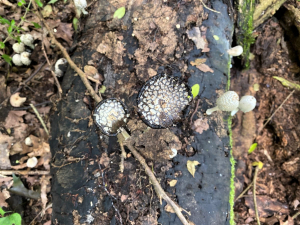
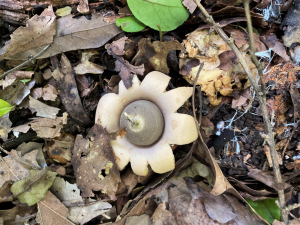
Amanita is another common genus. Mushroom Expert.com reports 113 Amanita species in the US and Canada. Wikipedia added some language that will dissuade me from attempting to collect any Amanita for personal consumption: The genus Amanita contains about 600 species of agarics, including some of the most toxic known mushrooms found worldwide, as well as some well-regarded edible species. This genus is responsible for approximately 95 percent of the fatalities resulting from mushroom poisoning, with the death cap accounting for about 50 percent on its own. I will not be seeking those well-regarded edible species anytime soon!
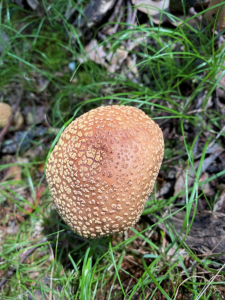
I am seldom confidant with my mushroom identification, yet this white cheese polypore (Tyromyces chioneus) seems reasonably certain. This pure white polypore must be very fresh, showing no smears, fading, or other signs of aging. Its mycelia are feeding on a several-years-dead fallen log, the wood bark-less, and seeming to me too far decayed to support such a spectacular specimen. Who am I to gauge what dead wood is best suited for a particular saprophyte. Nature knows best. I am simply an ignorant and arrogant interloper, thinking far too much and assuming I have the wisdom and knowledge to assess and evaluate organism/host relationships.
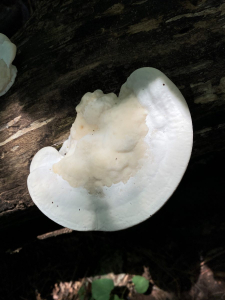
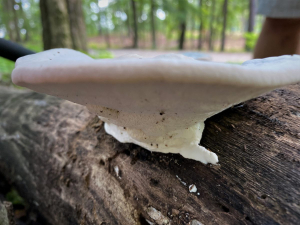
I believe this is a wood ear fungus (Auricularia) on a dead hackberry or sugar berry (Celtis sp). I’m told these are edible. However, I will need greater confidence before I harvest and saute! More recent rain would have encouraged a jelly-like consistency. These have desiccated and lost that soft feel and appearance.
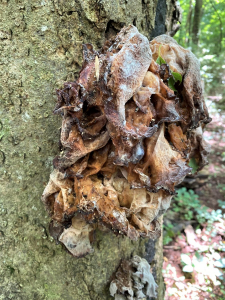
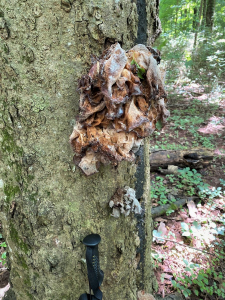
Mushrooms are the reproductive structure for fungi. So, allow me to segue thusly to the summer flowers (reproductive structures) we encountered along the Multi-Use Trail.
Summer’s Woodland Flowers
Tall bellflower (Campanulastrum americanum) added its blue hue occasionally at woods edge. It’s an unusual bellflower in that its flower is flat rather than ballooned. Neither Mike nor I could recall a prior sighting.
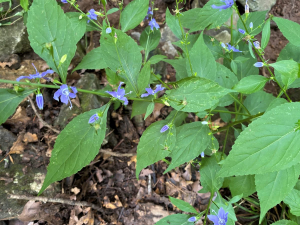
Blackberry (or leopard) lily (Iris domestica) surprised us along the trail in deep shade, suggesting a long ago residence landscaped with this showy eastern Asia ornamental import.
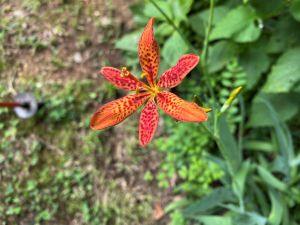
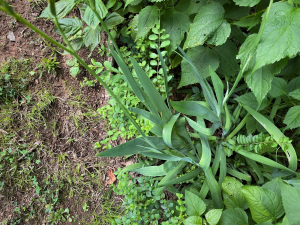
Hairy wood mint (Blephilia hirsuta) likewise blessed our mid-summer passage with unexpected delicate white. We both are more accustomed to the flush of forest understory spring colors and absolute abundance and variety from late March through mid-May in northern Alabama. Each summer understory bloom came with welcome surprise. To every season — a flowering inhabitant. The woodland flowering plant species frequency curve tales precipitously in these parts after the solstice. We embraced hairy wood mint as a gift.
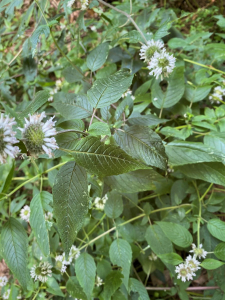
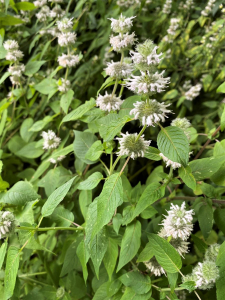
Interestingly, the trail crossed a several-hundred-foot-wide power transmission line (passing through the Park… originating from the Wheeler Dam hydro-turbines) in full sun. We saw summer blossoms in diverse abundance, stopping only to photograph this purple passionflower (Passiflora incarnata). The open-land flower frequency curve peaks mid-summer. We crossed the power line during the apex period. Why the seasonal disharmony? The sun hits the forest floor only prior to canopy leaf-out — the window of opportunity is short-lived in deep woods. It’s either bloom during spring… or generally not at all. The power line provides full summer sun.
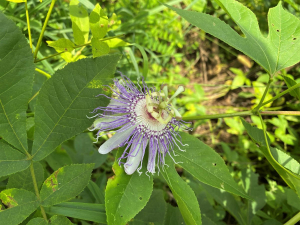
We strolled in the woods, savoring every moment, examining anything that caught our interest, and looking deeply enough to truly see. Our intent crossing the power line in full hot July sun was simply to reach the forest shade on the other side!
Alabama State Parks Foundation
I’ll remind you that I serve on the Alabama State Parks Foundation Board, in part because of my love of Nature and in recognition for my writing many prior Posts about visiting and experiencing the Parks. I urge you to take a look at the Foundation website and consider ways you might help steward these magical places: https://asparksfoundation.org/ Perhaps you might think about supporting the Parks System education and interpretation imperative: https://asparksfoundation.org/give-today#a444d6c6-371b-47a2-97da-dd15a5b9da76
The Foundation exists for the sole purpose of providing incremental operating and capital support for enhancing our State parks.
Thoughts and Reflections
Leonardo da Vinci’s timeless wisdom applied once again… this time along Joe Wheeler State Park’s Multi-Use Trail:
Human ingenuity will never devise anything more beautiful, nor more simple, nor more to the purpose than nature does, because in her inventions nothing is lacking and nothing is superfluous.
Inhale and absorb Nature’s elixir. May Nature Inspire, Inform, and Reward you!
Note: All blog post images created & photographed by Stephen B. Jones unless otherwise noted. Please circulate images with photo credit: “©2020 Steve Jones, Great Blue Heron LLC. All Rights Reserved.”
Another Note: If you came to this post via a Facebook posting or by an another route, please sign up now (no cost… no obligation) to receive my Blog Post email alerts: http://eepurl.com/cKLJdL
And a Third: I am available for Nature-Inspired Speaking, Writing, and Consulting — contact me at steve.jones.0524@gmail.com
Reminder of my Personal and Professional Purpose, Passion, and Cause
If only more of us viewed our precious environment through the filters I employ. If only my mission and vision could be multiplied untold orders of magnitude:
Mission: Employ writing and speaking to educate, inspire, and enable readers and listeners to understand, appreciate, and enjoy Nature… and accept and practice Earth Stewardship.
Vision:
- People of all ages will pay greater attention to and engage more regularly with Nature… and will accept and practice informed and responsible Earth Stewardship.
- They will see their relationship to our natural world with new eyes… and will understand more clearly their Earth home.
Tagline/Motto: Steve (Great Blue Heron) encourages and seeks a better tomorrow through Nature-Inspired Living!
Steve’s Three Books
I wrote my books Nature Based Leadership (2016), Nature-Inspired Learning and Leading (2017), and Weaned Seals and Snowy Summits: Stories of Passion for Place and Everyday Nature (2019; co-authored with Dr. Jennifer Wilhoit) to encourage all citizens to recognize and appreciate that every lesson for living, learning, serving, and leading is either written indelibly in or is powerfully inspired by Nature.
I began writing books and Posts for several reasons:
- I love hiking and exploring in Nature
- I see images I want to (and do) capture with my trusty iPhone camera
- I enjoy explaining those images — an educator at heart
- I don’t play golf!
- I actually do love writing — it’s the hobby I never needed when my career consumed me
- Judy suggested my writing is in large measure my legacy to our two kids, our five grand kids, and all the unborn generations beyond
- And finally, perhaps my books and Blogs could reach beyond family and touch a few other lives… sow some seeds for the future


All three of my books (Nature Based Leadership; Nature-Inspired Learning and Leading; Weaned Seals and Snowy Summits) present compilations of personal experiences expressing my (and co-author Dr. Wilhoit for Weaned Seals and Snowy Summits) deep passion for Nature. All three books offer observations and reflections on my relationship to the natural world… and the broader implications for society. Order any and all from your local indie bookstore, or find them on IndieBound or other online sources such as Amazon and LifeRich.

